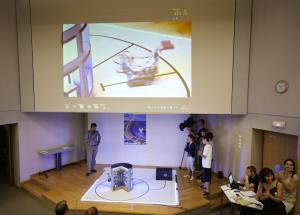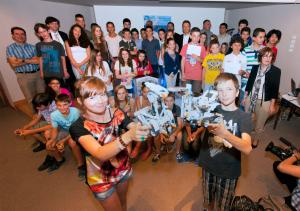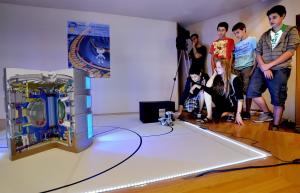ITERminator wins first ITER robot contest
22 Jun 2012
-
Robert Arnoux
The contest was based on a simulation of a real-life situation: the remote-handled removal of selected blanket modules from the inner wall of the vacuum vessel. Here, the team from Sainte-Tulle Junior High and their ITERminator
Ten or fifteen years from now, some of the students from the neighbouring schools may wish to work at ITER or in one of the many fusion labs around the world paving the way towards fusion energy. So why not get an early start and begin training for, let's say—remote handling?
Such was the idea behind the First Student Robot Contest (Premier concours scolaire de robotique) that Agence Iter France and the ITER Organization jointly organized this Tuesday, 19 June. The contest was based on a simulation of a real-life situation, one that will occur over the 20-year course of ITER operation: the remote-handled removal of selected blanket modules from the inner wall of the vacuum vessel, followed by transport of the modules to the nearby Hot Cell Facility.
Students from the Provence-Alpes-Côte d'Azur International School in Manosque and from nearby Collège (junior high) Pierre-Gardot in Sainte-Tulle—all aged 13 or 14—had accepted to take on the challenge.
The contenders aged 13-14 and their robot champions. Jean-Pierre Friconneau, ITER remote handling responsible officer (left) presided the jury that included Assembly & Operations Division Head Ken Blackler (left), Remote Handling Section Leader Alessandro Tesini (centre) and Hot Cell & Radwaste Services Integration Section Leader Magali Benchikhoune (right).
As both teams performed the last adjustments to their robot, ITER Assembly & Operations Division Head Ken Blackler addressed the contenders. "ITER will be the first fusion machine to produce a burning plasma. Because of the resulting radiation, it will be impossible for humans to enter the vacuum vessel. We will need many robots..."
Although simplified to the extreme, the remote handling operations were quite challenging for the small school-made robots. Both robots, ITERminator 5.1 from the Sainte-Tulle team and RTX Ariane 26 from the Manosque team had to follow a specific path, materialized by black lines on the floor. The path led to a mockup of the ITER Tokamak in the centre of the stage, where the robots needed to pick up a small plastic piece representing a four-ton blanket module, pivot, and head back to a black box representing the Hot Cell Facility to deposit the blanket module.
The robots had to perform the operation three times on three different modules. Instructions on the final module were given only at the last moment, requiring the teams to program their robot in the heat of the action.
As the robot from the International School began its journey toward the mockup, it became clear that something was wrong with its electronic brain. RTX Ariane 26 experienced serious difficulty in following the lines, seemingly preferring "freestyle" to compulsory figures. Despite a last-minute reboot, it never quite managed to fulfil its mission.
Tough times for RTX Ariane 26 from the International School in Manosque: the little robot never quite managed to fulfil its mission.
True to its name, ITERminator 5.1 proved invincible: its performance was nearly faultless and brought to the Sainte-Tulle Junior High a clear victory.
The competition was just a game and, as such, "the essential was not to have won but to have fought well ..."
There was a moral, however, to be drawn from the experience. "You can do something great on paper," Ken Blackler told the contenders, "but the real test is in the confrontation with reality. Things rarely work the first time."
In the young students' efforts, co-host Alain Becoulet, head of CEA's Institute for Magnetic Fusion Research, saw the reflection of "two of the greatest challenges in fusion research": the necessity of working together on one same object, and the necessity of being patient. "In fusion," he said, "the timescale is larger than an individual's lifespan..."




